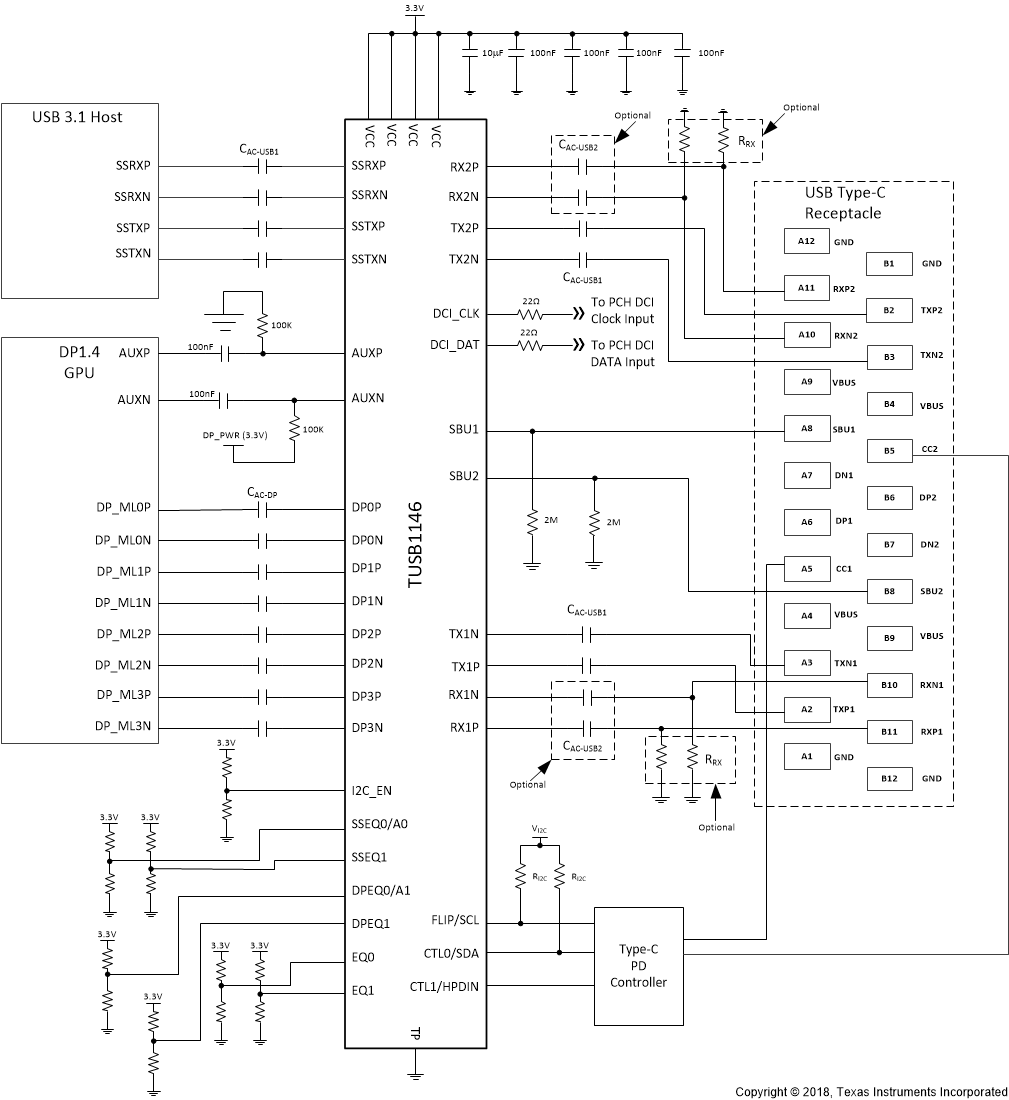SLLSFB2 April 2020 TUSB1146
PRODUCTION DATA.
- 1 Features
- 2 Applications
- 3 Description
- 4 Revision History
- 5 TUSB1146 Pin Configuration and Functions
-
6 Specifications
- 6.1 Absolute Maximum Ratings
- 6.2 ESD Ratings
- 6.3 Recommended Operating Conditions
- 6.4 Thermal Information
- 6.5 Power Supply Characteristics
- 6.6 Control I/O DC Electrical Characteristics
- 6.7 USB and DP Electrical Characteristics
- 6.8 DCI Electrical Characteristics
- 6.9 Timing Requirements
- 6.10 Switching Characteristics
- 6.11 Typical Characteristics
- 7 Parameter Measurement Information
-
8 Detailed Description
- 8.1 Overview
- 8.2 Functional Block Diagram
- 8.3 Feature Description
- 8.4 Device Functional Modes
- 8.5 Programming
- 8.6
Register Maps
- 8.6.1
TUSB1146 Registers
- 8.6.1.1 General_1 Register (Offset = 0xA) [reset = 0x1]
- 8.6.1.2 DCI_TXEQ_CTRL Register (Offset = 0xB) [reset = 0x6C]
- 8.6.1.3 DP01EQ_SEL Register (Offset = 0x10) [reset = 0x0]
- 8.6.1.4 DP23EQ_SEL Register (Offset = 0x11) [reset = 0x0]
- 8.6.1.5 DisplayPort_1 Register (Offset = 0x12) [reset = 0x0]
- 8.6.1.6 DisplayPort_2 Register (Offset = 0x13) [reset = 0x0]
- 8.6.1.7 AEQ_CONTROL1 Register (Offset = 0x1C) [reset = 0xF0]
- 8.6.1.8 AEQ_CONTROL2 Register (Offset = 0x1D) [reset = 0x20]
- 8.6.1.9 AEQ_LONG Register (Offset = 0x1E) [reset = 0x77]
- 8.6.1.10 USBC_EQ Register (Offset = 0x20) [reset = 0x0]
- 8.6.1.11 SS_EQ Register (Offset = 0x21) [reset = 0x0]
- 8.6.1.12 USB3_MISC Register (Offset = 0x22) [reset = 0x44]
- 8.6.1.13 USB_STATUS Register (Offset = 0x24) [reset = 0x41]
- 8.6.1.14 VOD_CTRL Register (Offset = 0x32) [reset = 0x40]
- 8.6.1.15 AEQ_STATUS Register (Offset = 0x3B) [reset = 0x0]
- 8.6.1
TUSB1146 Registers
- 9 Application and Implementation
- 10Power Supply Recommendations
- 11Layout
- 12Device and Documentation Support
- 13Mechanical, Packaging, and Orderable Information
Package Options
Mechanical Data (Package|Pins)
- RNQ|40
Thermal pad, mechanical data (Package|Pins)
Orderable Information
9.2.2 Detailed Design Procedure
A typical usage of the TUSB1146 device is shown in Figure 34. The device can be controlled either through its GPIO pins or through its I2C interface. In the example shown below, a Type-C PD controller is used to configure the device through the I2C interface. When configured for I2C mode and system does not support DCI, pins 29 and 32 can be left unconnected. If DCI is supported in the system, then connect through a 22-ohm resistor DCI_CLK and DCI_DAT to appropriate PCH GPIO pins. In I2C mode, the equalization settings for each receiver can be independently controlled through I2C registers. For this reason, all of the equalization pins (EQ[1:0], SSEQ[1:0], and DPEQ[1:0]) can be left unconnected. If these pins are left unconnected, the TUSB1146 7-bit I2C slave address will be 0x12 because both DPEQ0/A1 and SSEQ0/A0 will be at pin level "F". If a different I2C slave address is desired, DPEQ0/A1 and SSEQ0/A0 pins should be set to a level which produces the desired I2C slave address.
 Figure 34. Application Circuit
Figure 34. Application Circuit